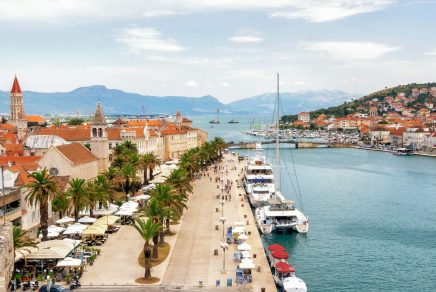Share the article
Table of Contents
Amsterdam’s Jordaan neighbourhood is an open-plan museum of both modern design and historical Amsterdam architecture, whether it means to be or not. The houses, sitting so low along the canals and tidy streets, often feature full-floor, street-level windows that allow intrepid (read: nosy) Canadian passersby to gaze in.
After a few days of observation, certain trends became clear in Dutch households: lots of white, sleek Danish furniture and retro or industrial lighting. But above all, we noticed a strange proliferation of tiny, blue-and-white porcelain houses painted in the traditional Delft style displayed in neat rows along the Jordaan’s windowsills.
These are the Dutch homage to Amsterdam’s distinctive architecture, and have been crafted since the 1950s. Nearly 100 of these sculptures now exist, and most represent a real house somewhere in the Netherlands. The Dutch are proud of them; in the antique shops along the Singel, Amsterdam’s central canal, they’re arranged into tiny porcelain villages where treasure-hunters seek the rare editions, some costing upwards of a few hundred euros.
The houses represent a real Dutch passion for famous buildings and historical Amsterdam architecture in particular. The city, particularly the old city near the Jordaan, is flush with examples of classic Dutch buildings. Many of these can be spied from the ubiquitous canal boat tours, but in good weather you can easily save a few euros by strolling the length of the Prinsengracht, the outermost canal that encircles the old city, to see the best buildings from dry land.
Amsterdam buildings have a few key features that make them unique. For one, they’re impossibly narrow and impractical, with steep, narrow staircases that make walking up and down the stairs a challenge, let alone moving furniture in and out. To solve this, the crafty Dutch affixed a study metal hook at the top of each building for hoisting heavy items in and out through the windows.
The tops of Dutch buildings are generally the most appealing. The first four floors don’t vary a great deal, simple brick and wide windows with black or white shutters, but in the roofs’ design, the architects found a way to express themselves. Some have square attics; others, like the delightfully named Crowned Turnip (Oudezijds Voorburgwal 57, across from the Oude Kerk), look like, well, a turnip. The Wynand Focknik Tasting House (Pijlsteeg 31, just east of the National Monument), a traditional pub, has a roof fittingly shaped like the top of a carafe of wine.
Amsterdam’s architectural history and its political history cross paths at many points. One of the more traditional examples of Amsterdam architecture is also its most-visited canal house, the Anne Frank House (Prinsengracht 263). The building where Anne Frank famously hid from the Nazi invasion of Amsterdam is now a museum, though visiting takes considerable patience as lines often circle the block.
If history and museums aren’t fully your areas of interest, but architecture is, walk on the opposite side of the canal, gaze at the Anne Frank House from a distance, and continue south across Raadhuisstraat before crossing the canal. This is the north edge of Amsterdam’s hip Nine Streets (De 9 Straatjes), a canal-crossing mishmash of tiny homes and some of the city’s best stores, cafes and bars. It’s easy to lose a day to the Nine Streets, and well worth it. Some of the buildings here are so old that they tip inwards over the street.
After a bite or a beer or both, head back toward the outermost of the four small canals (Prinsengracht) for more of Holland’s best canal houses. End your stroll back in Jordaan with a quiet glass of Palm and some Dutch fries at any of the small, friendly pubs along the canals, and rest up for another day of building-gazing in Amsterdam.







